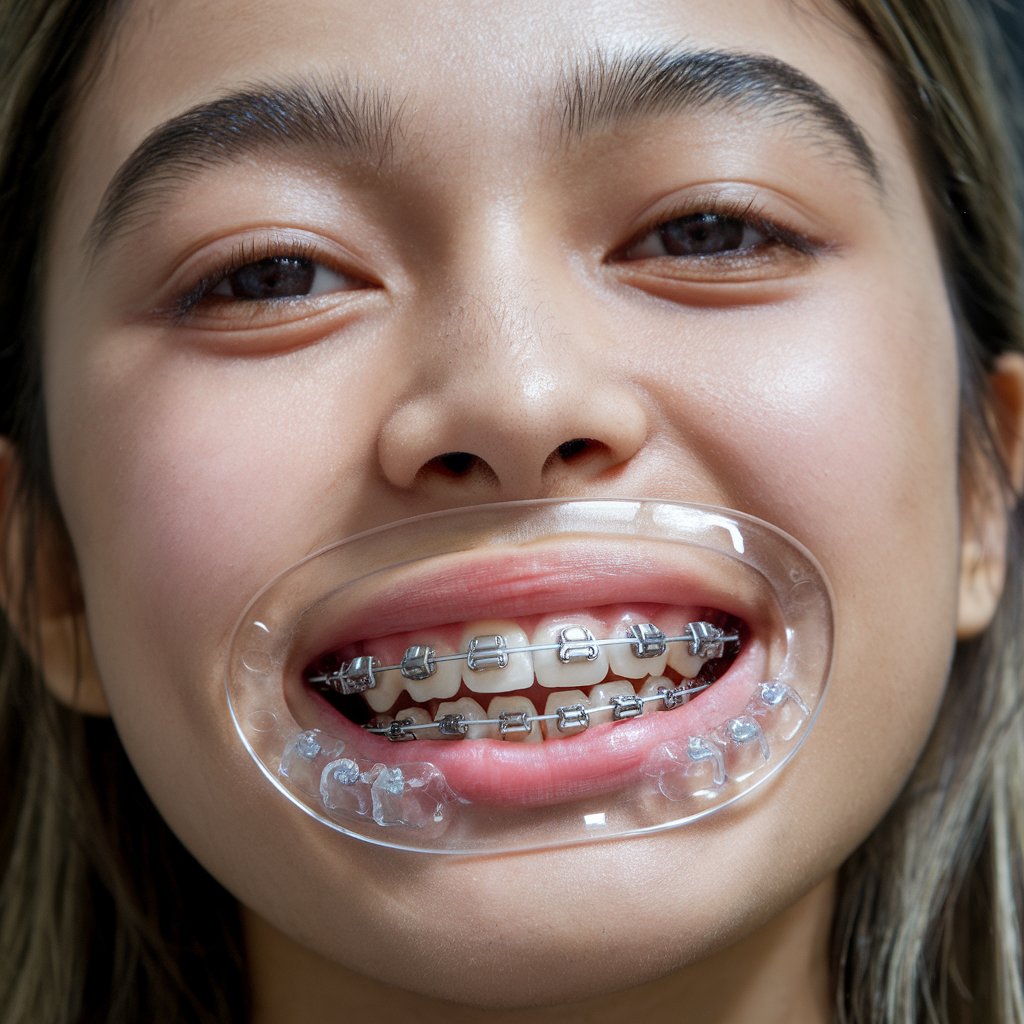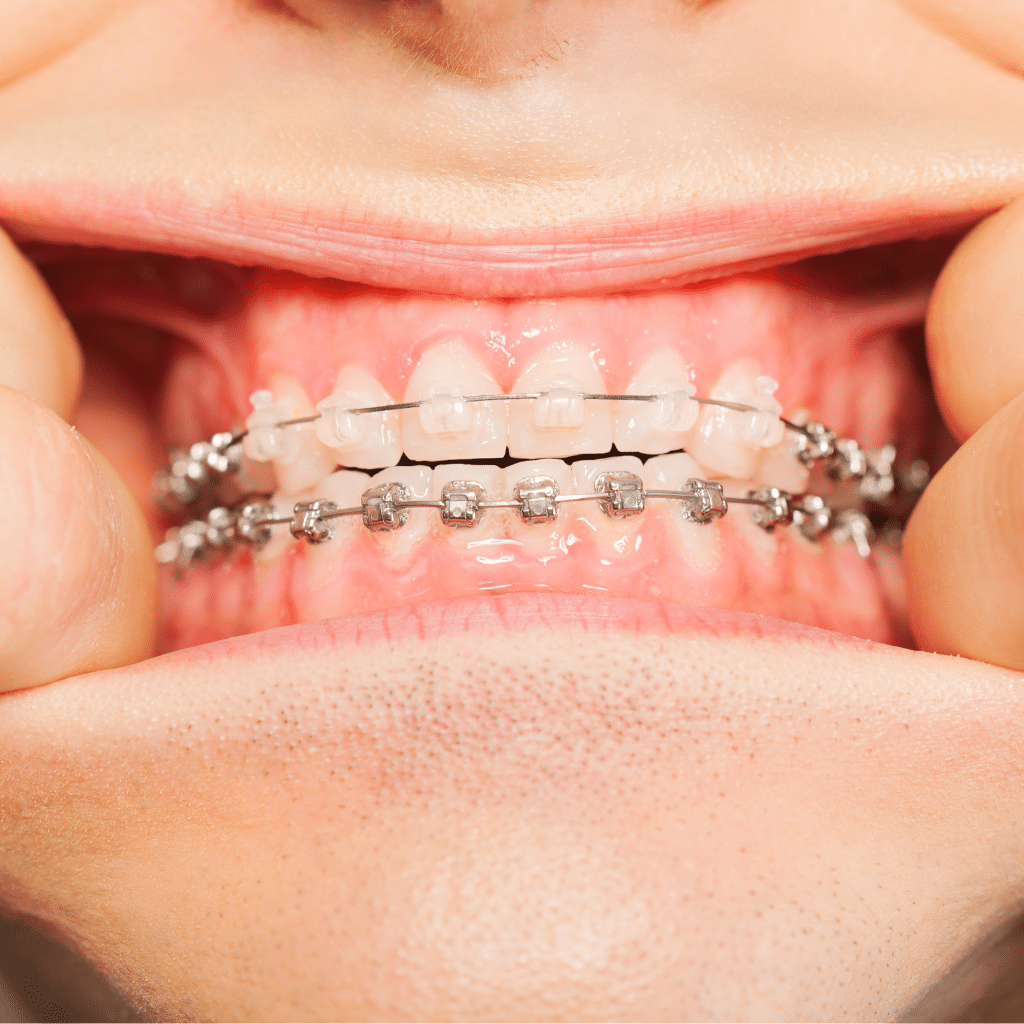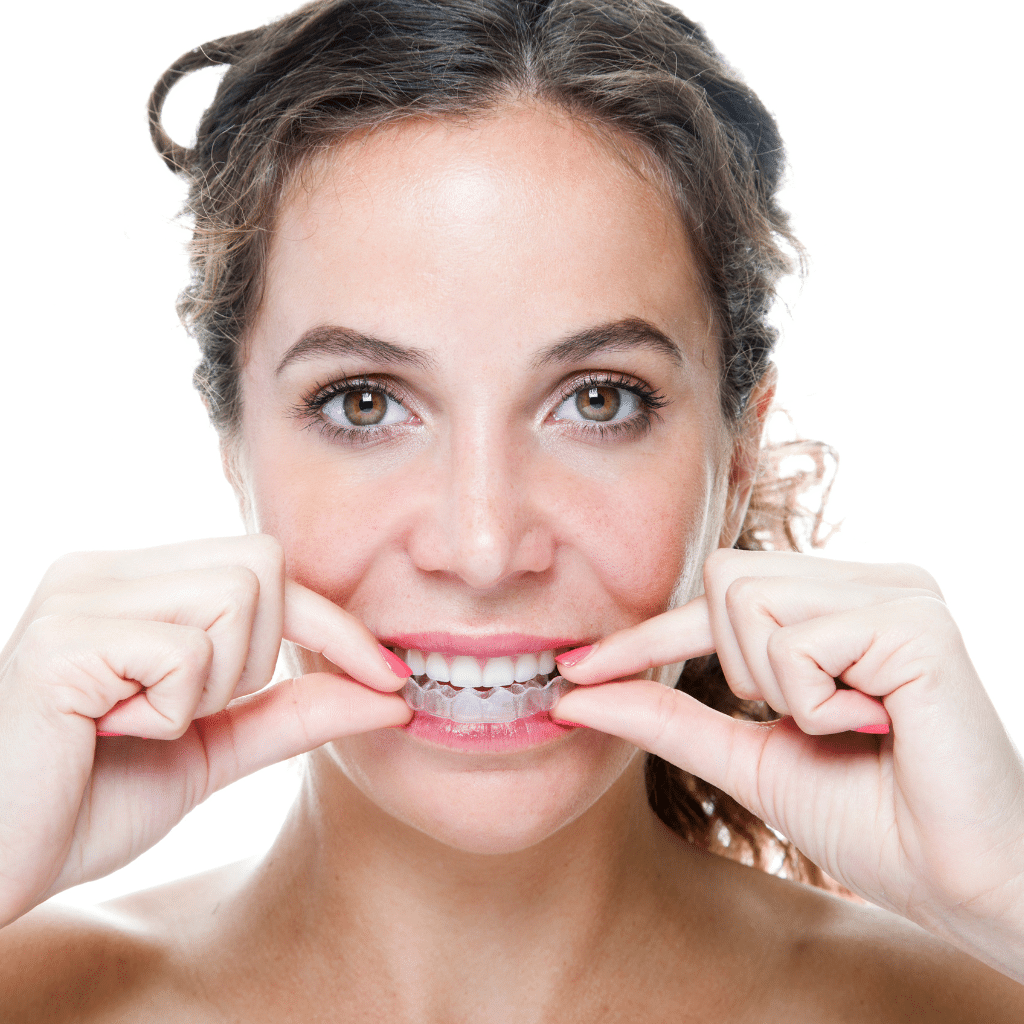Clear and metal braces differ in several key aspects. Clear braces use ceramic brackets and sometimes tooth-colored wires for a discreet look, while metal braces utilize stainless steel for durability. Metal braces are stronger and handle complex cases better, while clear braces require gentler handling. Aesthetic concerns make clear braces appealing, although they are costlier. Both types require regular maintenance, impacting effectiveness and satisfaction. Delving deeper offers insights into making informed orthodontic choices.
Key Takeaways
- Clear braces use ceramic brackets for a discreet look, while metal braces use visible stainless steel brackets.
- Metal braces are more durable and suitable for complex cases, whereas clear braces need careful handling.
- Clear braces offer aesthetic benefits but are generally more expensive than metal braces.
- Metal braces provide precise adjustments with fewer visits, which is beneficial for complex orthodontic needs.
- Clear braces cause less gum irritation, offering greater comfort compared to metal braces.
What are the Differences Between Clear Braces and Metal Braces?
Clear braces and metal braces differ primarily in materials and aesthetics, impacting their functionality and appearance.
Clear braces utilize ceramic brackets and sometimes tooth-colored wires to provide a more discreet look, whereas metal braces employ stainless steel for robust support.
These variances influence the overall visibility and strength of each type, dictating their suitability based on patient preferences and orthodontic needs.
Understanding the Orthodontics Behind Each Type
When considering orthodontic options, understanding the distinctions between clear braces and metal braces is essential for making an informed decision.
Orthodontics offers a variety of solutions, including traditional braces and clear aligners. Metal braces, composed of metal brackets and wires, are highly effective due to their durability and strength.
However, the appearance of metal braces often deters patients seeking aesthetic discretion. In contrast, clear braces, often referred to as ceramic braces, use tooth-colored or clear brackets and wires, providing a more subtle appearance.
The clear braces vs metal debate hinges on pros and cons such as visibility, strength, and cost. While clear braces offer aesthetic advantages, metal braces are typically more robust and efficient for complex orthodontic cases.
The Role of Brackets and Wires
Although both clear and metal braces serve the primary function of aligning teeth, the materials and design of their brackets and wires introduce distinct differences that impact performance and aesthetics.
Clear braces utilize ceramic or composite clear brackets, offering a less conspicuous option compared to traditional metal braces, which employ metal brackets. The wires in clear braces are often less visible, typically coated with a tooth-colored material, while metal braces use stainless steel wires.
Clear and metal braces diverge in several ways:
- Bracket Material: Clear brackets are ceramic, metal brackets are stainless steel.
- Wire Coating: Clear braces often have tooth-colored wires; metal braces use uncoated wires.
- Durability: Metal brackets are generally more robust.
- Friction Levels: Metal brackets typically offer lower friction.
- Adjustment Frequency: Metal braces may require fewer adjustments.
Aesthetics: Less Noticeable vs Traditional Look
In the domain of orthodontics, aesthetics play a pivotal role in a patient’s choice between clear and metal braces. Clear braces, often featuring tooth-colored or transparent clear brackets, are designed to be less noticeable, appealing to those seeking a discreet appearance.
These braces blend seamlessly with natural teeth, minimizing visibility and consequently enhancing aesthetic appeal. Conversely, metal braces present a traditional look, characterized by their visible metal brackets and wires.
While metal options are more conspicuous, they have been the standard in orthodontic treatment for decades. The choice between clear braces vs metal braces is often dictated by the wearer’s preference for either a subtle, less noticeable orthodontic solution or embracing the classic, traditional look of visible metal braces.
How Do Metal Braces and Clear Braces Work?
Both metal and clear braces function by applying continuous pressure to teeth, gradually moving them into the desired position.
Traditional metal braces utilize brackets and wires made of stainless steel, while clear braces typically use a ceramic material that blends with the natural tooth color.
The choice between these options depends on aesthetic preferences and specific orthodontic requirements.

The Functionality of Traditional Metal Braces
Traditional metal braces operate through a systematic application of continuous pressure to gradually move teeth into their desired positions.
Metal braces use brackets affixed to each tooth, connected by an archwire that exerts force. These traditional braces are made of high-grade stainless steel, which is known for its durability and effectiveness.
Metal braces are generally favored for complex orthodontic cases due to their robustness.
Metal braces offer several advantages:
- Durability: Made from strong materials, these braces withstand various dental forces.
- Precision: Metal ones efficiently correct severe misalignments.
- Adjustability: Braces treatment can be fine-tuned by orthodontists.
- Cost-effectiveness: Typically less expensive than other options.
- Versatility: Suitable for a wide range of dental corrections.
Braces require regular adjustments to guarantee they continue to apply appropriate pressure as teeth move.
Exploring How Clear Braces Work
While traditional metal braces are renowned for their strength and versatility, clear braces offer a more aesthetically pleasing alternative without compromising functionality. Clear braces work by using tooth-colored brackets made of ceramic materials, making them less visible than metal braces. These brackets are affixed to the teeth using orthodontic adhesives and are connected by wires that apply consistent pressure to align the teeth effectively. Clear braces can be either self-ligating braces or traditional braces, where elastic bands are used to hold the wires in place.
| Feature | Clear Braces | Metal Braces |
|---|---|---|
| Material | Ceramic | Stainless Steel |
| Visibility | Less visible | Highly visible |
| Durability | Moderate | High |
| Aesthetic Preference | High | Low |
| Bracket Type | Tooth-colored brackets | Metal brackets |
In orthodontics, clear braces maintain both functionality and appearance, appealing to those seeking discretion.
Choosing Between Clear Braces and Metal Braces
When selecting between clear braces and metal braces, understanding the functional and aesthetic differences is essential.
Metal braces vs clear braces offer distinct characteristics that may influence a patient’s decision. The choice between clear braces and metal braces often hinges on several factors:
- Appearance: Clear braces are less visible, offering a discreet option compared to traditional metal braces.
- Cost of Braces: Metal braces are generally more affordable, making them a cost-effective choice.
- Pros and Cons of Clear: While aesthetically pleasing, clear braces may stain easily and require diligent maintenance.
- Durability: Metal and clear braces differ in strength, with metal braces being more robust and resistant to breakage.
- Treatment Duration: When comparing clear braces vs. metal braces, traditional metal braces may offer faster treatment times.
What are the pros and cons of clear and metal braces?
When evaluating the pros and cons of clear versus metal braces, several factors must be considered, including cost, aesthetics, and treatment efficacy.
Clear braces often present a higher expense but offer a more discreet appearance compared to metal braces, which are typically more economical.
The patient’s aesthetic preferences also influence the choice between the two, as the visibility of metal braces can impact their decision.
Advantages and Disadvantages: Clear Braces vs Metal Braces
Although both clear and metal braces serve the primary function of correcting dental alignment, they offer distinct advantages and disadvantages that cater to different preferences and needs.
Clear braces, often tooth-colored and less visible, appeal to those prioritizing appearance. Metal braces, the traditional choice, are effective and durable.
- Appearance: Clear braces are less visible than metal braces, providing a more discreet option for wearers.
- Effectiveness: Metal braces are traditionally more effective in complex orthodontic cases.
- Durability: Metal braces are more robust and less prone to damage than clear braces.
- Cost: Metal braces generally incur lower costs compared to clear braces.
- Pros and Cons: Clear braces offer aesthetic pros, but can be less durable, while metal braces are reliable but more visible.
Are Clear Braces More Expensive Than Metal Braces?
Without a doubt, the cost is a pivotal factor when choosing between clear and metal braces. Clear braces tend to be more expensive than metal braces due to the materials used and their aesthetic appeal. The cost of braces can vary considerably depending on the orthodontic provider, geographical location, and specific treatment plan.
Metal braces are the traditional choice and are generally more affordable compared to clear braces. When evaluating metal braces or clear braces, patients should consider the long-term financial implications.
Clear braces offer a discreet appearance, which may justify the higher expense for some individuals. Choosing between clear, metal, and clear options involves weighing the pros and cons of each type, including financial considerations and personal preferences in orthodontic treatment.

The Influence of Appearance on Decision
Deciding between clear braces and metal braces involves evaluating aesthetic preferences alongside functional considerations. A significant factor in choosing between clear braces vs metal braces is their appearance.
Clear braces may appeal to those who prefer a less conspicuous treatment option, as they use tooth-colored or clear brackets, making them less visible than metal braces. This subtlety can be essential for individuals concerned about how braces look during social or professional interactions.
- Aesthetic Appeal: Clear braces are often chosen for their discreet appearance.
- Visibility: Clear braces are less visible than metal braces.
- Material: Clear braces use tooth-colored or clear brackets.
- Social Considerations: Some may choose clear braces to maintain a professional appearance.
- Decision Factor: Appearance is a key factor when choosing between clear braces vs metal braces.
How to Choose Between Clear Aligners and Traditional Metal Braces?
Selecting between clear aligners and traditional metal braces involves evaluating several critical factors, such as the specific orthodontic needs of the patient and the aesthetic preferences.
Consulting with an orthodontist is essential to determine the most suitable option based on the complexity of the dental correction required.
Additionally, considerations such as the cost of treatment and personal comfort levels should be assessed to make an informed decision.
Factors to Consider When Choosing Between Clear Braces
The decision involves gauging various factors that highlight the pros and cons of each. Clear braces serve as an alternative to traditional braces, offering aesthetic benefits. Metal braces, while more noticeable, provide robust correction and require regular adjustments.
Comparing clear braces and metal braces involves considering:
- Aesthetic Preferences: Clear braces offer a discreet look compared to metal braces.
- Treatment Complexity: Metal braces provide better results for complex cases.
- Lifestyle and Discipline: Clear braces demand adherence to wearing schedules.
- Maintenance and Care: Metal braces require regular orthodontic visits.
- Cost Considerations: Clear braces can be more expensive than metal braces.
Each option presents distinct advantages and limitations, influencing the final choice.
Consulting with Your Orthodontic Professional
While evaluating orthodontic options, consulting with a qualified orthodontic professional is crucial for making an informed decision between clear aligners and traditional metal braces. Each option presents unique pros and cons. Clear braces offer aesthetic advantages, whereas metal braces are known for their effectiveness in complex dental cases. For those unsure when to begin treatment, understanding the average age to get braces can help in making timely and effective choices. Consulting helps identify which method aligns with specific dental needs.
| Option | Pros | Cons |
|---|---|---|
| Clear Braces | Aesthetic appeal | May require more frequent adjustments |
| Metal Braces | Effective for complex dental issues | Less visually appealing |
The orthodontics professional assesses dental conditions, considering factors like age, lifestyle, and dental complexity. Traditional braces might be more effective for certain misalignments. Consulting guarantees a personalized approach, providing clarity on whether clear braces or metal braces best fit the dental requirements.
Deciding Based on Cost of Braces and Personal Preference
The decision often hinges on several factors, including financial implications and aesthetic desires.
The cost of getting braces can vary greatly based on the type chosen. Clear braces, including ceramic options, typically have a higher price point than metal braces but offer a less noticeable appearance. Understanding the difference between clear and metal options helps in making an informed choice.
- Cost: Metal braces are generally more affordable.
- Aesthetics: Clear braces offer a less conspicuous look.
- Durability: Metal braces are more robust.
- Maintenance: Clear braces require more careful cleaning.
- Personal Preference: Some prefer the traditional look of metal braces, while others opt for the discretion of clear aligners.
Considering these aspects can aid in a well-rounded decision.
Are Clear Braces Worth the Investment?
The evaluation of whether clear braces are worth the investment hinges on a comparative analysis of their effectiveness against that of traditional metal braces.
Clear braces offer distinct long-term aesthetic benefits, but these must be weighed against their typically higher cost and the potential variability in treatment duration for complex cases.
A thorough assessment of the pros and cons of each type will guide individuals in making an informed decision about their orthodontic treatment.

Comparing Clear Braces and Metal Braces for Effectiveness
Although both clear and metal braces serve the fundamental purpose of correcting dental misalignments, their effectiveness can vary based on several factors.
Clear braces are made of ceramic materials designed to blend with teeth, while metal braces are one of the most traditional and durable options, crafted from stainless steel.
The effectiveness of braces can vary widely depending on the complexity of the dental issue.
- Clear braces often provide a more aesthetic option compared to traditional braces.
- Metal braces are made for robust strength and are ideal for complex misalignments.
- Braces are effective in aligning teeth, though clear ones may require more frequent adjustments.
- Metal braces are one of the most reliable solutions for severe cases.
- Clear braces work like traditional metal braces, yet might demand more maintenance.
Long-term Benefits of Clear Braces
Investing in orthodontic treatments such as clear braces offers numerous long-term benefits, particularly regarding aesthetics and comfort.
In orthodontics, clear braces provide a significant advantage over traditional metal braces by enhancing appearance through their discreet nature. This discretion allows individuals to maintain confidence throughout the treatment.
The materials used in clear braces are designed for durability, ensuring they withstand daily wear while maintaining their aesthetic appeal. Additionally, the comfort level of clear braces is superior, minimizing irritation to the gums and cheeks compared to metal options.
Although the initial cost may be higher, the reduced maintenance requirements and the overall satisfaction derived from their unobtrusive appearance make clear braces a worthwhile investment in the long term.
Weighing the Pros and Cons of Each Type
When evaluating the choice between clear and metal braces, it is essential to contemplate their respective advantages and disadvantages.
Clear braces offer aesthetic appeal due to their subtle appearance, making them the preferred option for those conscious about their image. Conversely, metal braces are often considered more durable and cost-effective.
To look at the pros and cons:
| Braces Type | Pros | Cons |
|---|---|---|
| Clear Braces | Aesthetic appeal, less visible, preferred for professional settings | Higher cost, potential staining, may require more maintenance |
| Metal Braces | Cost-effective, highly durable, suitable for complex cases | More noticeable, potential discomfort, longer adjustment period |
The difference between clear braces and metal braces primarily lies in visibility, cost, and maintenance.
Determining the best braces depends on individual priorities and orthodontic needs.
Conclusion
In summary, both clear and metal braces offer effective orthodontic solutions tailored to individual needs. Metal braces, known for their durability and cost-effectiveness, are ideal for complex dental issues. Clear braces, while more aesthetically pleasing, may require a higher investment and careful maintenance. The choice between these options should consider the patient’s lifestyle, budget, and orthodontic requirements. A consultation with an orthodontist is essential to determine the most suitable treatment plan, ensuring the best dental health and alignment.


